[ TI Book front page | TI99/4a Articles to read | TI Resources Page | PC99 Review | Emulator Programs contact - please use subject="pc99 page" to avoid spam trap!
NEW URL from November 2023 http://ftp.whtech.com/Users/stephen/tihistory.htm
Home Computing with Texas Instruments
In January 2020 at a Retro Computing meeting held in Dallas, Texas, a "Dimension 4" computer was offered for sale. Shortly afterwards it went on sale on eBay and the numerous bids quickly drove it to over $500. This encouraged me to research more on the history of the TI99/4A online. This page is the result. Sources are listed at the end and include original documentation, and interviews carried out by others with former TI employees.In prehistoric times, Texas Instruments had made their name with transistors, logic chips, digital watches, calculators, business computers, toys with synthesised speech...
1960: engineers Ramon Alonso and Hal Laning employed at Texas Instruments, designed transistor "computers". The name of Hal Laning was later associated with the computer used in the first manned moon landing – in 1969. NASA used "a software architecture, much of which was designed by engineer Hal Laning."
Also in 1969, a "stored program" computer was designed by TI for machine control. It was fairly simple but still used 16 bit words- it was called a HAL-9. It sold about 50. A popular 1969 film featured a HAL 9000 computer where HAL stood for "Heuristically Programmed ALgorithmic Computer" [surely you remember 2001 A Space Odyssey].
1971 – The first "computer on a chip"- today it would be called a microcontroller– the TMS1802 with a 4 bit cpu and offered a four function calculator. The US Patent for a "microcomputer" was granted to Gary Boone and Michael J. Cochran of TI.
1974 – TMS1000 microcontroller, 4 bit cpu- very widely used in "Speak and Spell"– and microwave ovens, juke boxes, model train controllers. The rom included in the chip was programmed for each use and could not be repurposed for a different use. Hundreds of millions sold.
1976 – TI made a single chip 16 bit CPU- the 9900. They were also one of the manufacturers of the widely used 8080 chip (developed by Intel in 1974).
When designing a new product, you start with the initial concept – with concept artwork. The TI Home Computer concept promised a great deal indeed – it was at this time considered essential that the computer initially have a range of peripherals, and it was designed to be easy to use with peripherals not yet imagined. At the end of the day, our poor 99/4 was released with very few peripherals.

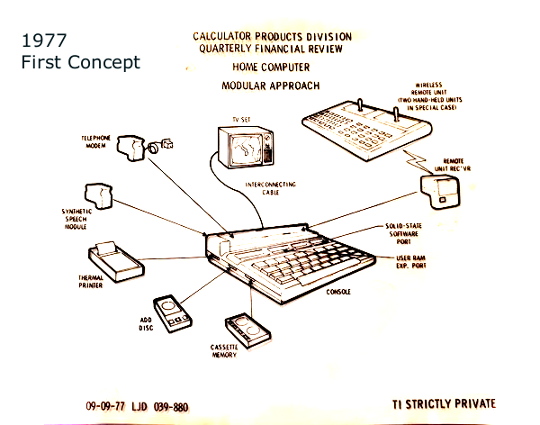
The original TI Home Computer designers had in mind a new CPU to run GPL natively, and there was a hint that a third party was interested, but no development funds were forthcoming. The TI Home Computer was then imagined as using a development of a 9940 chip, the 9985.
A third party had contracted for a cpu to run native GPL, and this was a target for a home computer. The third party dropped out and native GPL disappeared. From Karl Guttag: "when management wouldn’t pay for a cpu running native gpl, the engineers decided that they would do a real time gpl interpreter. Their hope was that the 99/4 would be so successful that they would get their own custom gpl cpu for the second generation. But in trying to reserve room for what they really wanted, they severely impacted the performance of the first system." Next CPU choice after a native GPL CPU: The 9940 chip - which was used in France but did not last long- was to be developed into the 9985. Sadly, this seems to have had a poor and severely bugged beginning, and resources to develop the 9985 were insufficient to overcome the initial fairly poor design work. It was estimated that at second design the failure rate would exceed 50%. [Compare to the later UK designed 9995 which passed first stage with just one bug issue].
The plan had became release of the 9985 equipped Home Computer towards the end of 1978 – for the valuable Christmas 1978 market – console, speech, cassette player, REMOTE joystick/keyboard, and modules: Health and Nutrition, Chess Master, Football, Investments, Diagnostic, Star Trek, Preschool.... and follow this up in the first quarter of 1979 with the thermal printer and modules: Spanish language, Audiovisual aids, Sign Language Tutor, Preschool, Music Tutor, Go/Reversi and Backgammon.
"Much of the required design effort thus far has been expended to insure compatability of the TI Home Computer console with future peripherals that are not yet designed...As a result the TI Home Computer has become a flexible mainframe computer. It is anticipated that third parties will capitalize on this flexibility to introduce their own specialized peripherals... furthering the move towards industry standardization."
"In the longer term, shopping by computer, electronic funds transfer, magazine/newspaper transmission and electronic mail are all possible extensions with no additional hardware development."
Proof of concept prototypes may be very different to a finished article, and if new technology is to be developed for them, they may initially use a very different technology- different chips, different operating system etc. The fine work is carried out when approval has been given to the IDEA of the original design! Hence there may be some really odd prototypes to make people wonder...
The initial designs were for Dimension 1 and Dimension 4 with IR remotes. These were based on a 9985 CPU. These may have been initial forms of 99/1 and 99/4.
The entire project depended upon this 9985 chip working. TI actually considered they might obtain a 70% market share of the Home Computer Market- note: NOT for a games playing console.
What was the market? Initially "early adopters" (technical nerds) would pay good money but the mass market was to be developed. TI was a big serious company, and games consoles were not in the picture. Was there a market for a serious home computer? How much should it cost and how many would sell?
TI was a major company with competing divisions, not working together, and not taking advantage of vertical integration. Business computers division did not want a home computer more powerful than their business computers - in 2020 it is normal for a dedicated serious games computer to be far more powerful than the average office computer. It did not help with internal politics for the Calculator Division to refer to a Home Computer Console as a "mainframe". Home Computers section had to be positive and upbeat towards Corporate, or be closed down - there was undue pressure to be overly optimistic at all stages.
Why GPL? GPL saved lots of memory. If you have sampled the Advertizer module you will have seen in TI Basic the power of using GPL, and how much smaller programs that use it can be. In essence a collection of powerful graphics and memory oriented macros. Imagine a CPU that could natively run GPL code instead of going through an interpreter.
Why GROM? Quite a cost saving as the chips have fewer pins. Do you NEED grom chips? No- the console could run with just ROM in the modules, or you could emulate grom technology with logic chips (as in the Advertiser module and the fg99 module of recent years). Personal Record Keeping module was written in Basic with some extra CALLs and ran the Basic from the module, allowing the vdp memory to be used for data storage. The fg99 module allows a TI Basic program image to be transferred to the vdp memory and run just as though it was loaded from tape.
The GROM design used an 8k address space and permitted nearly 1.4MB using bank switching. The grom could be used to hold programs in GPL, assembly, basic, or pure data.
The system architect Granville Ott has indicated that the concept of module grom was that modules would be third party, cheap, and protected. The GROM chips were cheap, and placing a program onto GROM was also very cheap and fast. This was the area that TI would make their profits. With a chip content costing cents and a retail price in tens of dollars, money was to be made - but a low chip price required bulk sales. A much earlier product, the TMS1000 chip had sold hundreds of millions using this concept of user content being added as a masking layer to an otherwise complete chip.
The initial module offering was not intended to include any blockbuster major sellers, but rather to indicate the width of subject possible. The choice was made after those misleading "focus groups" with the intention to offer a wide range for the average home so that overall the purchase of a home computer would be justified. The module software quality was to be good and ease of use was paramount. The source from third parties was to be encouraged - to do better, but this would take some months. The educational function was always seen as a major product area (with a possibility of an educational program built into the console).
The Securities Analysis module was an oddity, seen as a niche market, but one with no competition at that time. The total market for the module (out of a total USA population of 225 million [1979]) was seen as no more than 600,000.
A major selling area- and profit earner- was domestic connectivity, with security sensors and domestic appliances connected to a home computer, with remote access capability. Didn't happen, but we are drifting towards that dream in the 2020s with mobile phones.
The architects early concept was not understood, and was looked upon only as a "lock in" which was not the initial intent. When the 4A was released module protection was not an issue and modules with ROM were allowed until the rethink of Version 2.2.
Granville Ott indicated that GPL was designed to run on a CPU natively but the required personnel was not supplied, not enough to tackle the inevitable problems in a timely manner, and production costs could not be driven low enough. Granville also indicated that future expansion was designed in from the start with the DSR concept.
The first computer design progressed, based upon a 9985 chip and an 8 bit bus, with interpreted GPL - with plans for several varieties of build to suit all markets. Prototypes are proof of concept, design ideas, and models to test amongst the workers- there may be no finished product or the product that is marketed may be quite different, with some features removed for cost reduction.
Why no CPU ram? The VDP chip was designed for DRAM, initially for 4k DRAM- but the cost of DRAM fell so far the 4k fell out of use and TI had to use a 16k DRAM- which was largely unused but allowed spare memory for other uses- for BASIC programs for example. To add separate CPU ram would have added a few pence to the cost.
Prototype One? :-
 The "Dimension N" had a socket on the board to plug an Infra Red sensor into. This would allow input from complex remote wireless joysticks and a small 20 key pad, with a possibility of clipping two pads together to make a 40 key wireless keyboard. Now run the TI Diagnostic module and look at the joystick tests. I believe that TI Invaders had the code to work with wireless joysticks. Back in 1978/79. These were strong unique selling points and could have generated lots of sales (with the right software!). But adding the IR sensor would add a hundred dollars onto the selling price and no-one would pay that... possibly a number of TI99/4 consoles were sold with remnants of code from the IR sensor input and a few hundred early consoles had a socket on the motherboard.
The "Dimension N" had a socket on the board to plug an Infra Red sensor into. This would allow input from complex remote wireless joysticks and a small 20 key pad, with a possibility of clipping two pads together to make a 40 key wireless keyboard. Now run the TI Diagnostic module and look at the joystick tests. I believe that TI Invaders had the code to work with wireless joysticks. Back in 1978/79. These were strong unique selling points and could have generated lots of sales (with the right software!). But adding the IR sensor would add a hundred dollars onto the selling price and no-one would pay that... possibly a number of TI99/4 consoles were sold with remnants of code from the IR sensor input and a few hundred early consoles had a socket on the motherboard.
DIMENSION 4
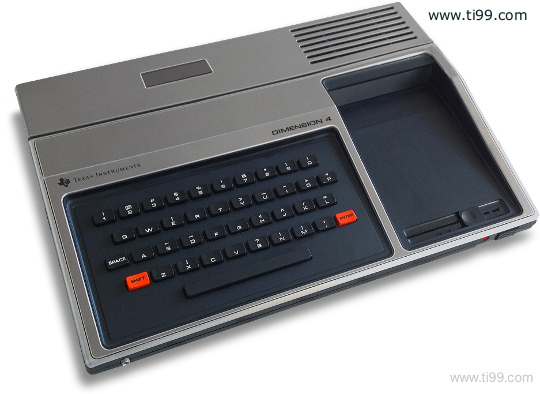
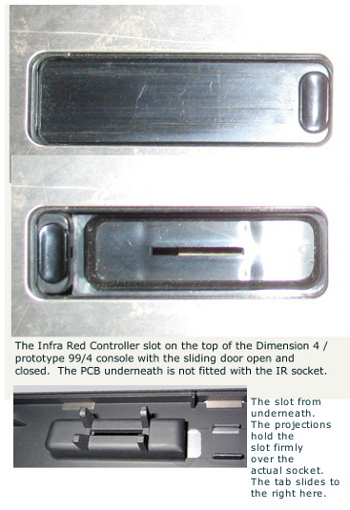
A small number of 99/4 consoles (low hundreds) had a video in socket on the board, to allow use of the vdp chip back board for video input onto which you could overlay computer messages and graphics. The video tape controller peripheral later used a relay to switch the screen display between tape and computer output.
1978 - And the 9985 didn't work yet. Lots of investment, a quickly filling market, something had to be done fast. It has been documented that use of a Z80 processor was considered- but even in a dire emergency use of a none TI chip was not internally acceptable and despite delays and costs another solution had to be found. The Z80 cropped up again later on.
Fortunately the initial power supply was designed for a 50% over load, and much of this was used to cover the additional requirements of the changes to be made.
Karl Guttag reports: "The U.S. managers at TI at the time were more the self-assertive, aggressive, “shoot from the hip,” cut corners (which resulted in the 9940/9985 debacle). Both the 9940 and 9985 were never fully functional, causing the designer to be discredited (whether at fault or not) and many people to leave."
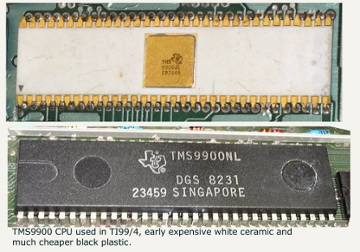 Emergency replacement chip to the rescue- Early version 9900 chips with white ceramic body (marked 9900JL) (later on, cheaper black plastic 1979 version 9900 chips were used- the 1979 redesign was more stable than the 1978 design.). These ceramic chips cost more and required some fast redesign work especially as the 9900 was a 16 bit chip. The 9901 chip was not needed for the 9985 design, but the change to a 9900 cpu needed it. Up goes the cost. And the computer has to output to SOMETHING... problems with the modulator meant initially a buyer had to buy an expensive monitor as well – the cost is now above the roof.
Emergency replacement chip to the rescue- Early version 9900 chips with white ceramic body (marked 9900JL) (later on, cheaper black plastic 1979 version 9900 chips were used- the 1979 redesign was more stable than the 1978 design.). These ceramic chips cost more and required some fast redesign work especially as the 9900 was a 16 bit chip. The 9901 chip was not needed for the 9985 design, but the change to a 9900 cpu needed it. Up goes the cost. And the computer has to output to SOMETHING... problems with the modulator meant initially a buyer had to buy an expensive monitor as well – the cost is now above the roof.
[Side note: white ceramic 9900 chips were also made to military specs and used in early satellites and missiles, the chips were marked SBP9900- these used a differing technology (I2L instead of NMOS) and could not be plugged into a 99/4 chip socket]
At first the use of the 9900 was considered temporary, to be replaced with a 9985, and design features took this into account. Karl Guttag: "So what you were left with was an old 16-bit CPU, that had hardware added that throttled its 16-bit interface to make it emulating the 9995 that was emulating the GPL CPU. Then you add to it the crazy way they had to go through the 9918 to get to any RAM other than the 256 bytes near the CPU. This is why the integrated circuit designers said the 99/4 had the best bag of parts but they were put together wrong.
March 1979 – TI encounter an uneven playing field with the need to obtain clearance for its separate video modulator to feed a domestic tv and are first refused consent. They ask for a rule change and meantime comment "We could market a home computer with a video monitor (a separate video display that would not require FCC approval)" but "it would mean a higher cost for initial buyers". At the time nearly all marketed computers used a built in monitor to avoid the need for approval.
The Dream
Very early on- in April 1979- Rex Naden put onto paper his thoughts on the way forward for the Home Computer product. How much of this made it out of the door?-General- Speech INPUT and output; Video disk; Data Tablet; Control of appliances; Health monitoring; Bitmap graphics.
Timing:
1980- solid state switching of 1000 watt 220 volt appliances
1980- one chip 1200 baud modem for $2
1981- microphone for speech recognition
1981- Extend fixed speech word list by using phonemes
1981- Communications through the power line for appliance control
1981- Programmable envelope music; speech in console
1981- Prepare for 64k ram (required minimum for 1983)
1981- Pne chip DAA for telephone link with auto dial.
1981- Non volatile memory (1Kx8) for console and modules
1981- 100k disk drive for $25
1981- replace 9900 with 9985
1982- Plug in devices for blood pressure monitoring, weight, moisture, wind direction and velocity, temperature
1982- Fibre Optic connection to applirances with high noise immunity
1982- Voice recognition chip- 20 words, speaker dependent.
1983- Console with 64k, bitmap graphics.
1985- General speech from text chipset
1985- Direct execution of GPL for 5x faster speed.
1985- Video disk interface for 100MB consumer storage.
June 1979 – the initial console was shown at CES, with no wireless peripherals (they were removed from the display just minutes before the unveiling). Terrible wired joysticks were produced. Expensive monitor required. Several of the initially planned items have not even been rumoured. It seems likely that a release in Autumn 1978 with wireless joystick/remote would have gained quite a few sales, but it didn't happen.
 The separate monitor was to be an interim move until FCC approval of the RF modulator - (approval was announced in Byte magazine in January 1980). TI became the first US personal computer manufacturer to send computer video to a domestic tv via an rf modulator.
The separate monitor was to be an interim move until FCC approval of the RF modulator - (approval was announced in Byte magazine in January 1980). TI became the first US personal computer manufacturer to send computer video to a domestic tv via an rf modulator.
Before the 4A – Home Computer manager Len Donohoe was replaced by Rex Naden. Rex' early thoughts have been found in writing see above . There came from somewhere a perception that he thought that no none-techie would buy a computer (the 1979 document says otherwise). He was then joined by Don Bynum who initially also took a high cost protectionist line but later softened. Don indicates he was given more (not unlimited) freedom to manage the project.
Rex Naden is "credited" with killing off the idea of remote controllers and remote keyboard. It was thought that he didn't think it would then be be a "real computer". It was perceived that Rex was dedicated to competing with Apple and lacked the ability to see the consumer market rushing past. The 1979 document above, originating with Ralph, indicates other thoughts. The Business part of TI would not allow the Home Computer division into more powerful computing territory. The little Home Computer lacked a credible future.
Rex Naden was offered an opportunity to respond to the comments and invited to add his perspective on the project but declined beyond stating:
"I’m proud to have been at TI for 11 years, it was (and is) good to me and
vice versa. I have good friends from those years too. I learned a lot
at TI, especially in Lubbock, and I learned a lot about the consumer
computer business. ...at this time I’m not going to weigh in on a program completed over 4
decades ago. We all gained, that’s what matters."
The only marketed TI 9900 series home computers were the 99/4, 99/4A, 99/2 and some 99/8 escaped.
The poor TI99/4 product was born out of desperation, changes to management and policy, and lack of experience, in a bit of a rush, with costs hitting the ceiling and the market developing away from the initial still unfinished design. And it got worse. And worse.
TI in Bedford England had a new Consumer Division tasked with selling a product they knew nothing about and were supplied with no information. An employee came up with some accepted module game designs- but could not produce the finished code as the UK had no development kit. Outside the USA only Nice in France had the ability to produce GPL and so that was where the Indoor Soccer module was programmed. Roger Tilbury designed the game and also Video Games 1. He later found more fame as one of the first UK IT Contractors to win against UK tax authorities with their infamous IR35 policy, when his claim to be a contractor and not an employee (paying more tax) succeeded.
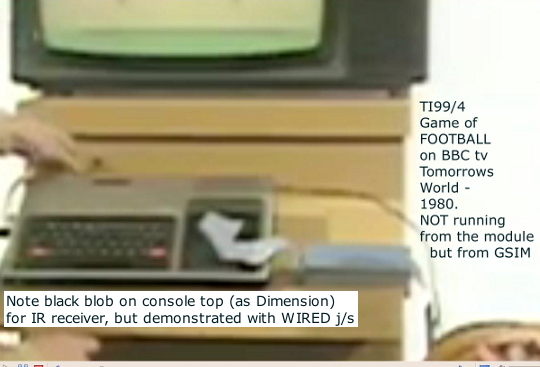
As a UK design, Indoor Football was demonstrated- before a module of it was made- on BBC Tomorrows World in June 1980. A clip can be found on youtube. No mention of Texas Instruments. The other end of the ribbon cable seen in the clip goes to a GSIM box, simulating a grom. The program demonstrated the new computer idea – the SPRITE. Karl Guttag was responsible (part of a team of 8) for the 9918 chip and the Sprite logic and control design.(Faq: the term sprite is credited to David Ackley)
The console seen on BBC tv had a black blob at the top of the console- we now know that this was the cut out for an Infra Red receiver for wireless joysticks, as seen on the Dimension 1 and 4 prototypes, but killed off in June 1979. The console on TW was shown with wired joysticks! (What happened to it?!). Now if the BBC had demonstrated wireless joysticks instead of a primitive two player game! And if TI had a PAL console on sale instead of taking another twelve months!
9918 chip and sprites: The older “player/missile” graphics design (eg Atari games) had the shape of the “players” in a small ROM and some dedicated timing registers that counted down to decide when to put them out. The 9918 was more of a processor in that it made two passes at the sprites. It first looked to see what sprites would appear on a given line and then later went back during horizontal retrace and got the sprite shape and colour information. The TI 9918 was used in Colecovision and MSX machines- and a redesign (not TI) was used by Sega and Nintendo.
The much later 9995 cpu was designed in Bedford – the design was by an American Karl Guttag, with leadership from Derek Roskell, an experienced employee there with a superb record of producing product that worked.
TI 99/4 and 4a's sold in the UK came with a variety of bought in RF modulators, set up in Nice for European PAL. I once had a phone call from an engineer with a very high tech tv who had no sound – I told him his TI used European PAL, he clicked a switch on his equipment and he had sound. The UK came late to 625 line PAL and the BBC opted for an improved version with better sound – but not fully compatible with European PAL. In the UK with your European TI99/4, you settled for a poor picture or poor sound, sometimes both – and the console was competing with computers with perfect tv displays. The colour difference signal from the VDP chip departed from standards in many ways (noted below) and probably contributed to the poor UK picture. (Tony McGovern reported problems in Australia with PAL tv, and also power supplies).
"In late 1980 Don Bynum moved to Lubbock to take over the home computer group from Pete Bonfield (who moved on to become Chairman and Managing Director of ICL in England). Don drove the 99/4a and peripheral box efforts, and later the 99/2 and 99/8." (Schuurman).
After a poor start with the 99/4, the engineers were horribly demoralised and needed a wake up call – according to Don Bynum: "It seems like we built 7 or 8 Z80 Rangers I had one, but trashed it many years ago. The purpose of the Ranger was to shock the Home Computer engineering troops out of the stupor of "can't do it" that they were in after the screwed up launch of the original 99/4."
In 2020 a schematic of a Z80 based TI home computer was made available.
[(The Rangers were internally referred to as a 99/7, not to be confused with the equally short term internal use of "99/7" to describe a terminal which became Model 715)]
Just a small demonstration with NO serious thought of using the chip. This odd story has produced much incredulity, but the words are direct from Don Bynum himself, associated with an equally weird team morale boosting technique, not via a long rumour mill or an unsourced web page. So – two different occasions when the Z80 was mentioned. Re failure of 9985 cpu- we have written documentation on that. And a kickstart to the 4A team, details from Don Bynum.
June 1981 – a design spec was produced to drop a 99/4 into a terminal case to provide an intelligent terminal – the 765 terminal was in the end made with two CPUs, the 9980 and an 8080. This would have been a 99/7, the 7 coming from the 700 series of the terminals. Probably not intended as a name to be marketed but merely a link between the cpu board (9900) and the terminal range (700). A TI99/7 image you may find on the web is a 2005 photoshop, not real.
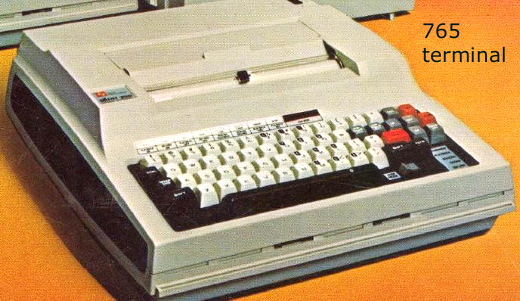
August 1981 – at last the 99/4a came along with an improved keyboard, better vdp, better O/s, and other changes arrives for sale. In total possibly three million consoles were sold.
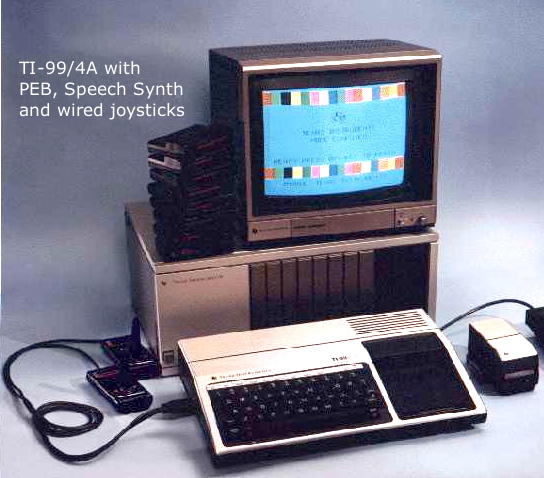
The TI99/4a USA power supply was from a third party and was also used in the Apple Lisa- and one Lisa set one house on fire as short circuiting the output made it get very hot. Tested by TI (in America) by UK born employee Rick Payne – oops, we need an inline fuse. TI had to replace 400,000 units – bad publicity and extra cost at the wrong time. And it was a precautionary recall which might not have been required. In 2020 house fires from chargers, batteries, white goods, seem now common.
Changes to components and the operating system seemed to be daily – if you see a very long list of known bugs, any one console possibly only had a couple. This made third party program support quite difficult as Extended Basic was also frequently modified and games would work well on one console and not well on another. More than five different makes of keyboard were used – latterly some insubstantial ones, one being liable to broken tracks as the board flexed, and one with rubber membrane switches, which rotted. The changes seemed to be very ad hoc, with no records kept and no version numbers. Construction appeared to almost be random.
Atarisoft produced modules without GROM, and experienced some difficulties, as several consoles (initial OS) showed what appeared to be corrupt characters when using some Atarisoft modules. Atarisoft had used the large character set from the initial Master Title Screen, and used direct addressing, so when TI moved it a bit, it was half a character out. was slightly relocated and Atarisoft had used direct addressing).
Atari (well, their contractors K Byte) needed more memory than they could address to run eg Pac-Man. ROM only. No bank switching. They put two memory chips on the same address and then used a little extra circuitry to "flip flop" which chip was active which switched when sent a "write to ROM" signal.
TI brought in an outside marketing guru- hotfoot from selling coffee – who suggested selling consoles at giveaway prices and selling very expensive modules – and locking third party software out. He was the first senior TI appointment from outside the company. It might have worked with a good supply of unique quality programs.
TI had been negotiating with third parties with the offer of placing their programs in modules and paying them a royalty. Several very promising programs were completed.
The initial concept of having modules written by third party developers who would pay for TIs technology worked well for Nintendo, with excellent software driving console sales. Third party agreements are "commercial confidential" and we have no information on the contracts TI entered into from time to time- but it is apparent from the module output that terms changed over time.
It had been thought that after a few months quality third party titles would predominate, but after a poor launch of a crippled product, low and declining sales, the middle period modules appear to have been licensed by TI and converted by their own staff for release- presumably paying a one off license fee and possibly per unit royalties to the original developers.
With the release of the TI99/4a third parties were able to make their own modules without touching TI – no income stream to TI to make up for losses on console sales – but some very fine modules were made. Quite likely TI asked the developers to pay a licence fee to use the TI logo and name.
Then mounting losses drove TI to reinstate the module lockdown with OS 2.2 requiring developers to pay for TI technology. We have no idea what up front fees TI asked developers for to pay for module production, or what reduced royalties they offered – but a number of third parties with completed software ready just pulled out. The commercial deal was not sufficiently generous for them. Today we have a number of "unreleased module" games which have "escaped".
TI cut costs with a major console redesign and a new operating system which was recorded on the boot screen – Vn 2.2, which refused to work with modules that lacked a GROM chip. Then the CRU line was removed from the module port (used for some bank switching). And worse...
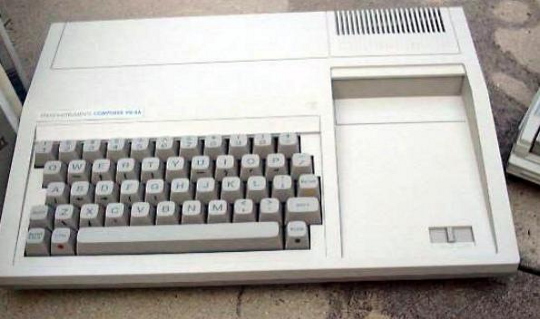
TI moved to a very liberal sale or return policy, and retailers stocked up with consoles they didn't have to pay for. TI knew how many consoles were out there- lots. But had no idea how many were sold, how many they would receive cash for, and how many were coming back to base. Money was disappearing in large amounts.
As an 8 bit computer design with a hastily shoe horned in 16 bit processor surrounded by 8 bit chips, and numbers of management errors, our TI99/4a computer is something of a miracle.
The TI Home Computer Family:
TI99/4 – a 40 key keyboard, slow, with no ability to load third party machine code games, costly peripherals, costly module software, limited third party support. It initially needed a special monitor.
TI99/4A – with a better keyboard, different VDP chip, many OS changes.
TI99/2 – shown in Jan 1983, cancelled April 1983. No colour, no sound. Hex bus peripherals. 9995 cpu. Built in RF modulator. Don Bynum indicated it had been developed with the purpose of scaring Timex (Timex Sinclair) out of the computer business (that worked). The storage was a "wafertape" which never worked reliably for any period- the read/write head was prone to fall out of alignment easily, quickly, and inevitably.
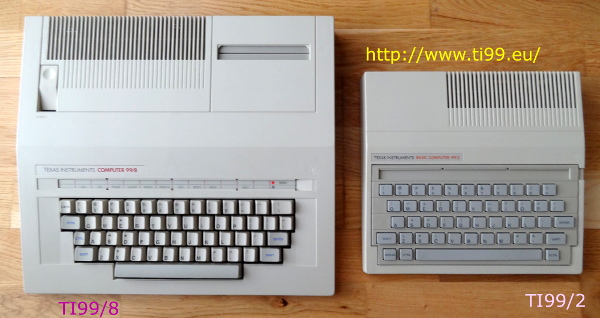 TI99/3 – In the initial plans as a cheap cut down TI99/4. The 99/3 would use an RF modulator, and the cheaper – hopefully finished – 9985 cpu. That CPU never made it. It would have resulted in only a small price drop for the 99/4 with tv signal, from $600 to $500.. An early 99/3 spec indicated a 6 pin serial port instead of the 44 pin side port. Support for only one cassette recorder instead of two. Not produced.
TI99/3 – In the initial plans as a cheap cut down TI99/4. The 99/3 would use an RF modulator, and the cheaper – hopefully finished – 9985 cpu. That CPU never made it. It would have resulted in only a small price drop for the 99/4 with tv signal, from $600 to $500.. An early 99/3 spec indicated a 6 pin serial port instead of the 44 pin side port. Support for only one cassette recorder instead of two. Not produced.
TI99/5 (TI99/4B)- a 99/4A but with a 9500 cpu (9995 without on chip ram) and Hexbus expansion, option to slow to 4A speed. A stripped down 99/8. The 4B was a 99/8 without the p-system and a /5 was a 4B with speech installed. Thoughts of adding ExBas or an RS232 to the console were not proceeded with.
The report on the Summer 1983 CES in Compute! refers to the 99/4B. The 4B concept appeared in January 1982. The 99/4B and 99/5 motherboards were quite different with the 4B able to run ROM only modules and with a PEB expansion possible. Prototypes only and probably not intended to be marketed with these numbers. Ten boards made, one discarded, three not populated, two known to exist. One working 99/5 has 48k cpu ram, possibly extendable to 64k. VDP ram was separate.

TI99/7- developed by "Corporate Engineering, Dallas" with no contact with the "Home Computer" division. A specification dated July 1981 described a TI99/4 inside a DSG765 terminal casing, with larger keyboard (58 keys), 80 column thermal printer, and 99/4 software compatability. TV out display 40x24. Tape interface.. Pascal grom. Speech onboard, TMS0285. Starting price US$5,000. Lack of cooperation between the two divisions meant this was not a contender for production.
The marketed 765 terminal used TWO CPUs, a 9980 (an 8 bit 9900) cpu plus an 8080 cpu. There is a photoshop image on the web of a 765 with a 99/7 badge.
Internally a mythical Z80 based Ranger computer was also referred to as a 99/7 for a short period.
TI99/8- cancelled October 1983. 64k ram. Speech and USCD pascal on board. Dropped the metal RF shield for lead paint just before lead paint was banned. An included speed option to slow it to 99/4A speed has not been found to be activated in existing models. Could connect to a PEB and also Hexbus peripherals. Up to 12MB of ram – could support 128MB. 300 preproduction units of which 150 considered finished. But 1000 PCBs were made – which someone could have populated. Boot screen displays vn 2.3. 9500 cpu (9995 without on chip ram)
AFTER TI
Third party modules were produced, including in 2019 a legally licensed module with the Arcade Classic game DRAGON'S LAIR, complete with the arcade animation and sounds –- the license was for only a small limited run. As TI had shown in 1980 that you could run GPL without GROM, in 2019 we had the FG99 module which simulated GROM and used an SD Card holder to allow users to have very nearly every possible module plugged in at one time with menu selection. Normal module size, using the unmodified console system. The FG99 proved most popular.
A long planned hardware unit was ready for market just as TI pulled the plug, and a few hundred of these units were released- the Milton Bradley MBX unit. This was a standalone computer- with more processing power than the 99/4A - which plugged into a 99/4a and used it for its video output and module slot. Most of the MBX modules worked with and without the MBX unit attached.
The MBX unit used a separate and different speech synthesiser, a very complex joystick, a touch pad, and speech recognition.... the peripheral was a vehicle for Milton Bradley to utilise technology they developed for their own intended home computer, which was dropped before launch due to the competitive market place.
In 2019 the availability of small cheap computers enabled a device known as a TIPI to be offered, which proved popular in linking the TI to a Pi computer, useful for example for adding storage and file transfer etc.
When TI withdrew from the market in 1983/4, the original plans to encourage third parties to produce unthought of peripherals produced quite a bloom of new third party product, unfortunately with little finance, small teams, and little marketing. A multitude of peripherals were produced, often in batches of well under a hundred, usually released with bugs, which were often never fixed, and sadly, conflicting with each other or with TI originals. The need for software to be rewritten for the new hardware also caused some leading independent software programmers to jump ship.
Most of the third party peripherals produced floundered due to bugs, incompatibilities, and lack of software.
The problem of attaching a European TI to a display device due to TI's use of colour-difference outputs, produced some popularity for a console modification (F18A) which also had some incompatibilities, but many people accepted those in order to get an output. TIs use of an RF modulator to provide UK tv signals meant that the modulator also contained custom circuitry to transfer the colour difference signal to an RGB signal. The circuitry had been published and was used for the TI Engineers-produced Cortex computer.
Intelligent Terminal - "Cyclops"
Around the end of the seventies the average remote terminal had no visual display (using a printer instead) and was the size of a dishwasher. Around Texas Instruments, there were these small boxes with CPUs and the possibility of connecting to a small CRT display. And so was born the Intelligent Terminal, with a phone line socket at the back, a four pin power in, and an RS232 socket. Software could be in a readily modified or changed module. Add a couple of switches for HALF/FULL duplex and VOICE/DATA and screw a small display unit on the top on a small stalk.
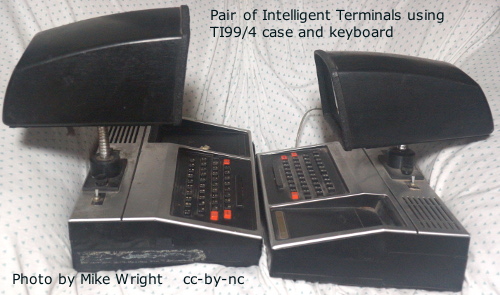
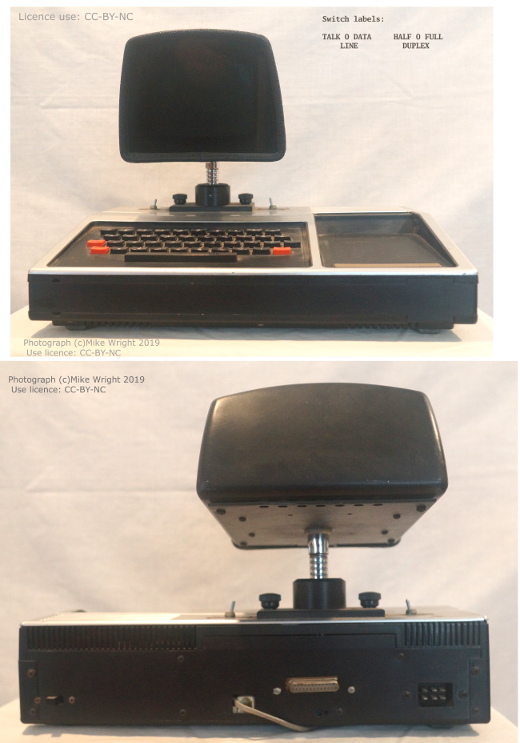
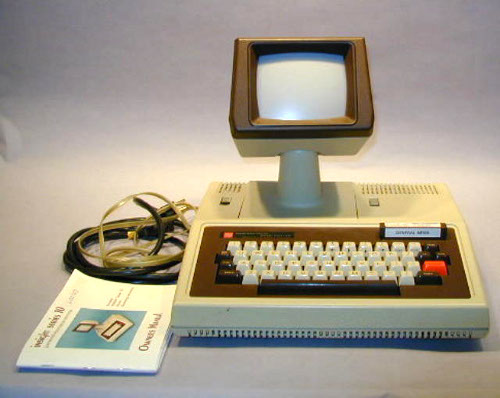
For the somewhat historic time, you have a small, portable and powerful enough remote terminal. This one in a TI case was a prototype designed by "Corporate Engineering" to demonstrate the feasibility of producing a low cost desk top terminal to access databases.. The two divisions of TI did not communicate with each other - some might say the Business division was hostile – and the use of 99/4 architecture in a business product wasn't going to happen.
Don Bynum indicated the Low Cost Terminal was developed in 1981, and a second version was produced ("Insight Series 10") with a more finished look. Sadly nobody wanted a 40 column display and TI Business Division kept the 80 column output to themselves.
The Insight 10 was announced in Computerworld in March 1981 with a 53 key keyboard, a 24x40 display and built in modem at a cost of US$995. The Command Module contained up to 8 macros of up to 32 characters. The same issue of Computerworld announced the French replacement of telephone directories with a home terminal, and the French introduction of Chip and Pin smart cards, with government installation subsidy to traders. The cards "would come to the USA sooner or later" – the USA is unique 40 years later in resisting chip n pin cards. The Insight 10 was most popular in France.
The 9918 video chip had some quality issues which put off third parties, and Coleco returned batches as unusable for their Colecovision. This may have been a factor encouraging Sega/Nintendo to design an improved version.
The lack of true bit map graphics with the 9918 has been put down to speed restrictions on the 8 bit bus. The design of the 9918 was with an eye to use elsewhere, with other processors – hence the designers avoided the intended CRU VDP interface and kept to the then common 8 bit bus- and thus TI made money by selling 9928A chips for use with the Z80 CPU in the 1982 Colecovision and the 1983 Sega SG1000.
A Nintendo employee preferred the Coleco smooth movement to the jumpy Atari movement and thus the 1983 NES was issued with 64 sprites – using a custom chip from Ricoh. The TI VDP designer was sure that Nintendo must have made use of his design work, but we need a Nintendo engineer to give us that information. There were no public patent problems.
In May 1982 the Dutch arm of TI's European Consumer Division highlighted problems with the video chip used in Europe, the 9929A, causing several problems with European PAL television sets- especially the picture being moved to the left of the screen. Problems highlighted with the 9929A involved: Incorrect Gamma requiring changes to Luminance and Colour Difference signals; Line sync timing; field sync timing; burst amplitude; and synchronisation signal level. For a chip designed for European use, it was not perfect and retained many NTSC levels/timings, but redesigning the chip would have been horribly expensive.
It must be noted that while the USA VDP chip had RGB output for direct connection to a monitor or rf modulator, the UK VDP was designed with a colour difference output, which could connect to almost nothing. Even very expensive devices with appropriate inputs still stumble with so many standards deviations as noted above. (TIs use of an RF modulator to provide UK tv signals meant that the modulator casing also contained custom circuitry to transfer the colour difference signal to an RGB signal to feed to the standard modulator.)
The 9995 cpu chip was designed in Bedford, UK. One UK TI employee upgraded his 99/4a with the 9995 CPU, and a group of UK TI employees designed their own CORTEX computer (9995 cpu, 16 bit).
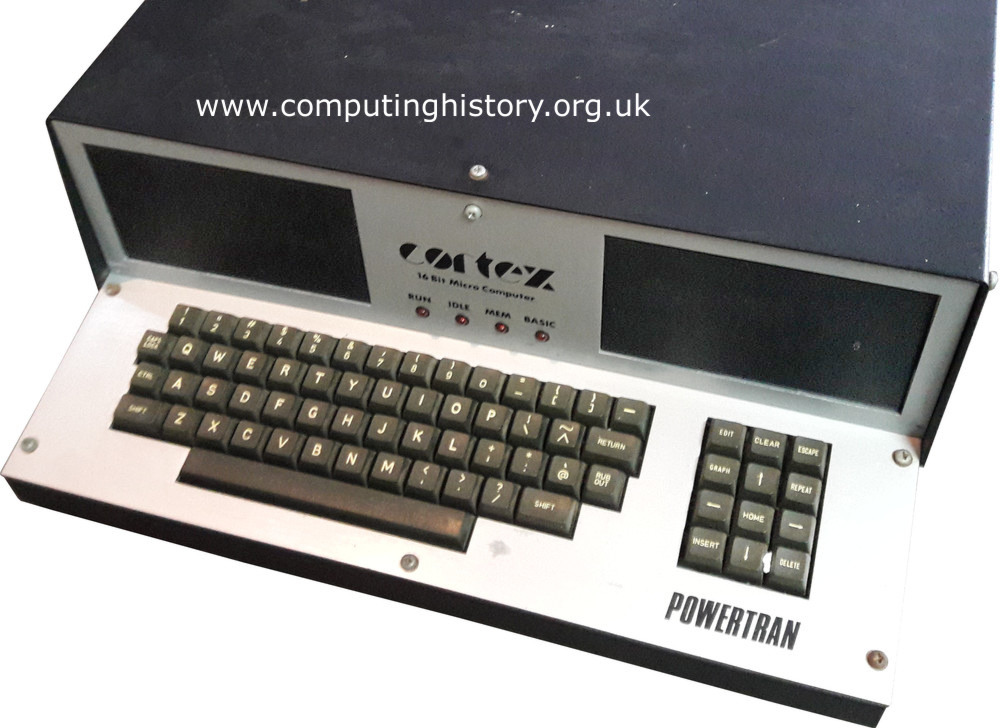 Meanwhile around 1983 TI engineers in France produced their own computer, the EXL100, (99+1!!) complete with speech synthesis and infra red joysticks on a TMS7020 8 bit cpu.
Meanwhile around 1983 TI engineers in France produced their own computer, the EXL100, (99+1!!) complete with speech synthesis and infra red joysticks on a TMS7020 8 bit cpu.
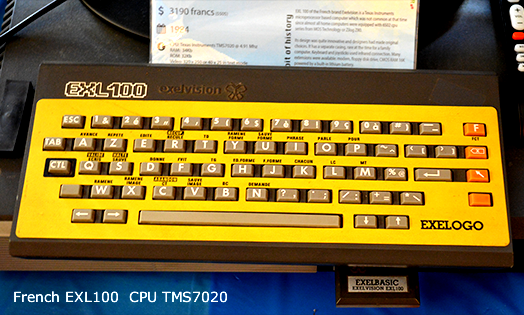 Important: There are no official TI stories about TI99/4A development and the above is taken from hints, gossip and memories of old employees of the time, who also did not have access to the full facts. There may be some errors. A remarkable number of the prototype and small run consoles still exist with several still in working order.
Important: There are no official TI stories about TI99/4A development and the above is taken from hints, gossip and memories of old employees of the time, who also did not have access to the full facts. There may be some errors. A remarkable number of the prototype and small run consoles still exist with several still in working order.